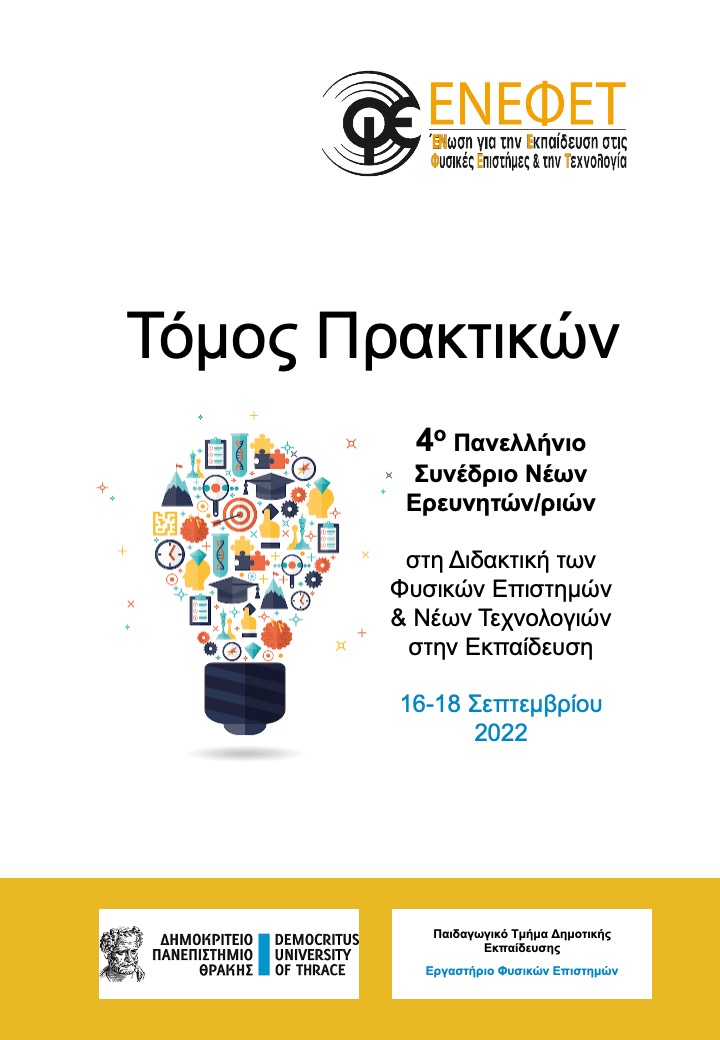ΔΙΕΡΕΥΝΗΣΗ ΤΩΝ ΔΙΑΣΥΝΔΕΣΕΩΝ STEM ΠΕΔΙΩΝ ΣΕ ΔΙΔΑΚΤΙΚΗ ΕΝΟΤΗΤΑ ΝΑΝΟΤΕΧΝΟΛΟΓΙΑΣ ΑΠΟ ΜΕΛΛΟΝΤΙΚΟΥΣ ΕΚΠΑΙΔΕΥΤΙΚΟΥΣ

Published:
Sep 14, 2024
Keywords:
boundary objects interdisciplinarity nanoscience-nanotechnology STEM education
Abstract
In a STEM teaching module, the identification of concepts that have both a common identity and different structure in various disciplines is crucial. In this paper, are presented concepts/ artifacts/ methods that prospective teachers recognize as boundary objects, as well as their characteristics in an integrated STEM module on Nanoscience – Nanotechnology developed as part of the ERASMUS+ project “IDENTITIES”. Twelve prospective teachers from four different countries (Greece, Italy, France and Spain) with a background in Science, Mathematics and Computer Science participated in the research, attending in a week-long summer school concerning interdisciplinary STEM approach.
Article Details
- Section
- ΜsCs
- Categories
References
Akkerman, S. F., & Bakker, A. (2011). Boundary crossing and boundary objects. Review of educational research, 81(2),132-169.
Araya, R., & Collanqui, P. (2021). Are cross-border classes feasible for students to collaborate in the analysis of energy efficiency strategies for socioeconomic development while keeping CO2 concentration controlled? Sustainability, 13(3), 1584.
Crujeiras-P., B. & Jiménez-Aleixandre, M. P. (2019). Interdisciplinarity and argumentation in chemistry education. In S. Erduran (Ed.), Argumentation in Chemistry Education: Research, Policy and Practice, pp32-61. London: Royal Society of Chemistry.
Czerniak, C. M., & Johnson, C. C. (2014). Interdisciplinary science teaching. In Handbook of Research on Science Education, Volume II (pp. 409-425). Routledge. ISBN: 978-0-203-09726-7
Duit, R., Gropengießer, H., Kattmann, U., Komorek, M., & Parchmann, I. (2012). The model of educational reconstruction–A framework for improving teaching and learning science. In Science education research and practice in Europe (pp. 13-37). Brill. ISBN: 9789460919008
English, L. D. (2016). STEM education K-12: Perspectives on integration. International Journal of STEM education, 3(1), 1-8.
Hobbs, L. (2013). Teaching ‘out-of-field’as a boundary-crossing event: Factors shaping teacher identity. International journal of science and mathematics education, 11(2), 271-297. https://doi.org/10.1007/s10763-012-9333-4
Honey, M., Pearson, G., & Schweingruber, H. (Eds.). (2014). STEM integration in K-12 education: Status, prospects, and an agenda for research. Washington, DC: National Academies Press. ISBN 978-0-309-29796-7
Klein, J.T. (2010). A taxonomy of interdisciplinarity. The Oxford handbook of interdisciplinarity, 15(6), 15. ISBN 9780198733522
Lefeber, L., & Vietorisz, T. (2007). The meaning of social efficiency. Review of Political Economy, 19(2), 139-164.
Leung, A. (2019). Exploring STEM pedagogy in the mathematics classroom: A tool-based experiment lesson on estimation. International Journal of Science and Mathematics Education, 17(7), 1339-1358.
Martín‐Páez, T., Aguilera, D., Perales‐Palacios, F. J., & Vílchez‐González, J. M. (2019). What are we talking about when we talk about STEM education? A review of literature. Science Education, 103(4), 799-822.
Mayring, P. (2015). Qualitative content analysis: Theoretical background and procedures. In Approaches to qualitative research in mathematics education (pp. 365-380). Springer, Dordrecht. https://doi.org/10.1007/978-94-017-9181-6_13
Moore, T. J., Johnson, C. C., Peters-Burton, E. E., & Guzey, S. S. (2015). The need for a STEM road map. In C. C. Johnson, E. E. Peters-Burton, & T. J. Moore (Eds.), STEM Road Map: A Framework for Integrated STEM Education (pp. 3–12). Routledge. ISBN 9781138804234
Moore, T. J., Stohlmann, M. S., Wang, H. H., Tank, K. M., Glancy, A. W., & Roehrig, G. H. (2014). Implementation and integration of engineering in K-12 STEM education. In Engineering in Pre-College Settings: Synthesizing Research, Policy, and Practices (pp. 35-60). Purdue University Press. ISBN 9781612493572
Roehrig, G. H., Moore, T. J., Wang, H. H., & Park, M. S. (2012). Is adding the E enough? Investigating the impact of K‐12 engineering standards on the implementation of STEM integration. School science and mathematics, 112(1), 31-44.
Star, S. L., & Griesemer, J. R. (1989). Institutional ecology,translations' and boundary objects: Amateurs and professionals in Berkeley's Museum of Vertebrate Zoology, 1907-39. Social studies of science, 19(3), 387-420.
Thibaut, L., Ceuppens, S., De Loof, H., De Meester, J., Goovaerts, L., Struyf, A., Boeve-de Pauw, J., Dehaene, W., Deprez, J., De Cock, M., Hellinckx, L., Knipprath, H., Langie, G., Struyven, K., Van de Velde, D., Van Petegem, P. and Depaepe, F. (2018). Integrated STEM Education: A Systematic Review of Instructional Practices in Secondary Education. European Jourrnal of STEM Education, 3(1), 02.





